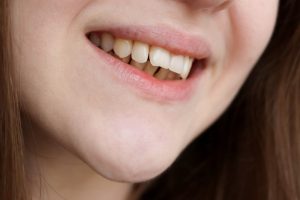
Dentleon İzmir Bornova, Çiğli, Güzelbahçe, Bayraklı Özel Diş Kliniği
What is a Tooth Lesion? What are the Symptoms of a Tooth Lesion?
19 August 2025

What is a Tooth Lesion? What are the Symptoms of a Tooth Lesion?
Oral and dental health is crucial not only for an aesthetically pleasing smile but also for maintaining our overall health. Any dental problem directly impacts numerous processes, from chewing to digestive function. One of these problems is dental lesions .
While often unnoticed, dental lesions can lead to both intense pain and serious tooth loss if they progress. Lesions, particularly those resulting from untreated cavities, inflammation of the dental nerves, or trauma, negatively impact a person’s quality of life.
Dental lesions detected early can be successfully controlled with appropriate treatment. Therefore, regular dental checkups play a critical role in maintaining oral health and preventing larger problems in the future.
So, what is a tooth lesion , what are its symptoms, and how is it treated? Here’s a comprehensive guide prepared by DentLeon…
What is a Lesion?
In medical terms , a “lesion” refers to the disruption or damage to the normal structure of a tissue. In other words, abnormal changes occurring in tissues that should be healthy are called “lesions.” Lesions can appear in various parts of the body, including the skin, internal organs, bones, or oral and dental tissues.
In dentistry , a lesion is a term used to describe pathological changes, particularly those occurring at the roots of teeth, surrounding bone, or gum tissue. These changes often develop as a result of infection, advanced caries, trauma (damage from impact), or inflammation of the dental nerve.
The size and location of the lesion determine the symptoms it causes. Some lesions may be small and go unnoticed for a long time, while others can grow rapidly, causing pain, swelling, and tooth loss. Therefore, the question “What is a lesion?” should be viewed not only as a medical definition but also as an important health warning that should be diagnosed early .
What is a Tooth Lesion?
The simplest answer to the question “What is a tooth lesion?” is that it’s a pathological deterioration that occurs at the root of a tooth or surrounding tissues. It’s often associated with an infection at the root and appears as dark shadows on X-rays. What is a lesion in dental terms? It often occurs as a result of advanced decay, inflammation of the dental nerves, or trauma to the tooth. Lesions can occur at the root of a tooth, especially if root canal treatment is necessary.
What are the symptoms of dental lesions?
Not every dental lesion presents with obvious symptoms. However, there are some common signs to watch out for:
– Severe toothache (especially worse at night)
– Sensitivity or pain when chewing
– Swollen or red gums
– Swelling that can cause facial asymmetry
– Bad breath
– In more advanced cases, purulent discharge.
If even one of these symptoms is present, a dentist should be consulted.
How to Diagnose a Dental Lesion?
To diagnose dental lesions, dentists generally use the following methods:
– Clinical examination: The tooth’s response to pain, gum swelling, and tenderness are assessed.
– X-ray (periapical or panoramic): Lesions are often seen as dark areas on X-rays.
– Patient history: Previous decay, trauma, or treatment history is inquired about.
Early diagnosis significantly increases treatment success.
How is Dental Lesion Treated?
Treatment for dental lesions varies depending on the size, location, and cause of the lesion. The most common methods are:
1. Root Canal Treatment:
This is the most common treatment option. The nerves of the tooth are removed, the canals are disinfected, and the lesion is filled. If the lesion originates from the root of the tooth, it usually heals successfully. For more information, please visit our root canal treatment
page. 2. Antibiotic Treatment:
If the infection has spread, your doctor can control the inflammation with antibiotics. However, antibiotics alone will not completely heal the lesion.
3. Surgical Intervention:
In some cases, a surgical procedure called apical resection may be used to remove the lesion from the root of the tooth.
4. Tooth Extraction :
In very advanced and incurable cases, the tooth may need to be extracted.
Healing Process After Dental Lesion Treatment
Recovery time after treatment varies from person to person, but is generally a few weeks.
Mild pain and swelling are normal in the first few days.
Medications prescribed by your doctor should be used regularly.
Hard foods should be avoided, and dental hygiene should be maintained.
The healing status of the lesion should be monitored with regular checkups.
Tips for Preventing Dental Lesions
Most dental lesions can be prevented with regular care and early intervention. Here are some important points to consider:
– Regular brushing and flossing
– Avoiding sugary foods
– Regular dental checkups (at least twice a year)
– Avoiding impacts to teeth
– Early treatment of cavities
Frequently Asked Questions About Dental Lesions
At What Ages Are Dental Lesions More Common?
Dental lesions can occur at any age. However, they are more common in older adults due to root problems and treatment history.
Is Tooth Lesion Dangerous?
If left untreated, it can be dangerous. The infection can spread to the jawbone, cause tooth loss, and even pose a risk of systemic infection in rare cases. Early diagnosis and treatment minimize these risks.
Conclusion
For those seeking answers to the question “What is a tooth lesion?”, this is a health problem that typically arises from an infection in or around the root of the tooth. Seeing a dentist immediately when you notice the symptoms is the most important step to saving your tooth.
At DentLeon, we diagnose and treat dental lesions as quickly as possible using our modern diagnostic and treatment methods. Don’t miss your regular checkups for a healthy smile.
Recent Posts



